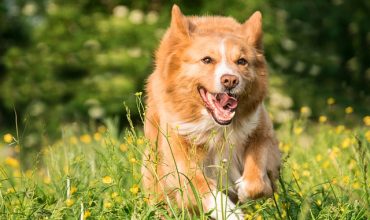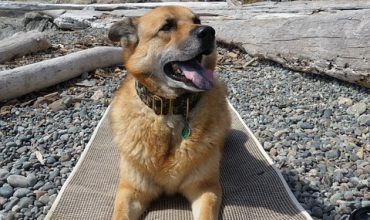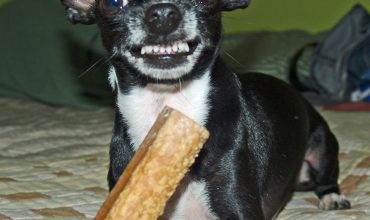[print-me] Training recall is very important. Recall is teaching your dog to come when called. To get your dog to come when called every time, follow the following Recall Rules Never call your dog for anything your dog won’t like. Never call your dog if you don’t think your dog will come. If you make a mistake on that last rule, go “save” the recall* (See below). Never repeat the command—say it only once and then make yourself interesting with a high voice, clapping, squatting, etc. Always give your dog a HUGE payoff—lots of treats and/or something novel and special.
Read More
Archives for Puppy or dog
Teaching “Go to your mat and lie down”
[print-me] Step One: Lure Lure your dog onto his mat by putting the treat up to his nose and slowly moving it over the mat. Keep the treat close to your dog’s nose—If you move your hand too quickly or too far away from his mouth he may give up and lose interest so be sure to move at your dogs pace. Step Two: Mark & Reward As soon as your dog has all four paws on his mat, say “yes” or click and treat. Step Three: Lure Immediately after, lure the dog into a down or ask for a
Read More
Teaching “Drop It”
[print-me] To teach a dog to drop something he has we start by “trading up” or giving him something of higher value. To teach “drop it,” complete the following steps: Give a dog a toy to play with. Play with him and the toy for a few seconds. While the dog is grabbing/chewing on a toy, say the command “drop it” and hold a treat up to his nose. Repeat this until the dog drops the toy immediately when you hold up the treat. If the dog does not release when you hold the treat up, try with a higher
Read More
Teaching “Down”
[print-me] Step One: Lure Start with your dog in a sit. Lure your dog into a down by putting the treat to his nose and slowly moving the treat down to the ground. Keep the treat close to your dog’s nose—if you move your hand down too quickly or too far away from his mouth, he may not understand what you’re asking. Step Two: Mark & Reward As soon as your dog’s knees and elbows hit the ground, say “yes” or click and treat. Keep treating him to thank him for staying in the down. After a few seconds say
Read More
Resource Guarding
[print-me] What is Resource Guarding? Dogs that become aggressive or possessive of an object or space are said to be resource guarding. By using threatening displays or aggression to get an approaching person or dog to move away, the dog is able to maintain possession of the resource that they value. While this behavior can be useful for wild or feral animals that have to fend for themselves, it can be problematic in a family pet. Fortunately, there are ways to modify it! What types of “resources” do dogs often guard? Anything the dog values can be something they will
Read More
Teaching “Leave It”
[print-me] On Surfaces Place treats on a table, coffee table, or counter where you are close enough to cover them up or remove them if needed. You can place them on a plate to imitate real life. When your dog shows interest tell him “Leave it.” If he looks away, click or use your marker word and reward him. If he goes for the food or jumps on the counter, immediately cover the food up and take the dog away. When he stops trying to get at it, mark and reward. Your reward should come from your pocket or somewhere
Read More
Clicker Training Basics
[print-me] Clicker training means using a sound (a click) to communicate with your dog. Clickers have been in use for more than forty years. The method is best known from the world of marine animal training where people need a way to communicate with animals like dolphins and orcas that can’t be controlled by physically forcing them to do things. How does it work? It is fabulously simple. First we teach the dog that the click means he has won a treat. Then we use the click to tell the dog when he has done something we like. Essentially: When
Read More
Anti-Jumping
[print-me] Why Dogs Jump Dogs jump up to say hello, quite simply. They don’t know how humans prefer to be greeted, and it never occurs to them that they might knock us over or ruin our clothes. Thankfully, consistent anti-jump training can quickly solve the problem for good. For this exercise, you’ll act as an on/off switch. When the dog is four feet on the floor, you’ll be “on” (verbal praise, petting, bending down to greet the dog, etc.). While the dog is jumping, you’ll be “off”(stand up, completely disengaged, no verbal attention, even in the form of “NO!”, turning
Read More
Afraid of the stairs? Or of getting into/out of the car?
[print-me] Note: These exercises can be adapted to entering and exiting cars and other motor vehicles. Is your dog afraid of steps and stairways? Perhaps past experiences led the dog to associate steps with something unpleasant, frightening and/or hurtful. Perhaps the dog was yelled at for going up or down a stairway, or had fallen down stairs during his formative weeks, or was pushed down the stairs. Maybe the dog has never encountered stairs before. Some people respond to such fears by forcing the dog up and down the stairs. But this approach doesn’t always provide the dog with an
Read More
Essential Dog Toys & How to Use Them
The things that are usually the most attractive to dogs are often the very things that are the most dangerous.
Read More
- «Previous Page
- 1
- 2
- 3
- 4
- 5
- 6
- 7
- Next Page»













